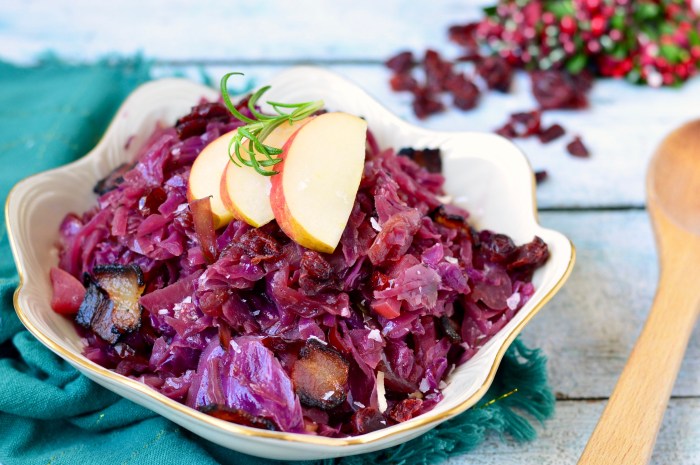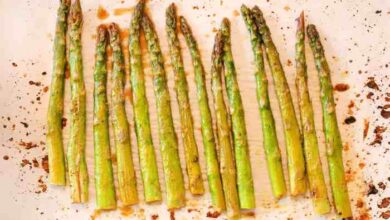
Red Cabbage and Apples: A Culinary and Nutritional Powerhouse
Red cabbage and apples, a dynamic duo that brings a vibrant splash of color and flavor to any dish. This unlikely pairing, though seemingly simple, is a testament to culinary ingenuity and a celebration of nature’s bounty. From their vibrant hues to their contrasting textures, red cabbage and apples offer a symphony of flavors that dance on the palate.
This blog post will delve into the fascinating world of these two ingredients, exploring their nutritional benefits, culinary versatility, and cultural significance.
We’ll journey through the world of red cabbage and apples, discovering their unique flavor profiles, exploring their diverse culinary applications, and uncovering the secrets behind their nutritional power. Join me as we uncover the hidden depths of this captivating duo, from their humble origins to their presence on the world’s culinary stage.
Storage and Preservation: Red Cabbage And Apples

Red cabbage and apples, both vibrant additions to our culinary landscape, require proper storage and preservation techniques to retain their freshness, flavor, and nutritional value. Understanding these methods allows us to enjoy these ingredients for extended periods and explore a wider range of culinary possibilities.
Storing Red Cabbage and Apples
Storing red cabbage and apples correctly is crucial for maximizing their shelf life and preserving their quality. Red cabbage, when stored properly, can last for several weeks, while apples can stay fresh for a few months.
- Red Cabbage:Store red cabbage in the crisper drawer of your refrigerator, wrapped in plastic wrap or a reusable food storage bag. This helps retain moisture and prevent the cabbage from drying out. Avoid storing red cabbage near fruits that emit ethylene gas, such as bananas and avocados, as this can accelerate spoilage.
- Apples:Apples are best stored in a cool, dry place, such as a cellar or a refrigerator. Avoid storing apples in direct sunlight or near heat sources, as this can cause them to ripen too quickly. For optimal storage, wrap individual apples in paper towels or newspaper, which absorbs excess moisture and prevents them from bruising.
Preserving Red Cabbage and Apples
Preserving red cabbage and apples extends their shelf life and opens up a world of culinary possibilities. These techniques allow us to enjoy these ingredients year-round, even when they are out of season.
Pickling
Pickling is a method of preserving food in a brine solution, typically made with vinegar, salt, and spices. This process inhibits bacterial growth and creates a tangy, flavorful product.
- Red Cabbage:Pickled red cabbage is a popular condiment, often used in sandwiches, salads, and as a side dish. To pickle red cabbage, finely slice the cabbage and combine it with a brine solution containing vinegar, salt, sugar, and spices.
The mixture is then heated to a boil and allowed to cool before being stored in sterilized jars.
- Apples:Pickled apples, known as apple chutney, are a sweet and tangy condiment that complements savory dishes. Apples are sliced or diced and combined with vinegar, sugar, spices, and sometimes onions and other fruits. The mixture is simmered until thickened and then stored in sterilized jars.
Fermenting
Fermentation is a process that uses microorganisms, such as bacteria or yeast, to break down sugars and create lactic acid. This process not only preserves food but also adds unique flavors and textures.
- Red Cabbage:Fermented red cabbage, known as sauerkraut, is a traditional German dish that is often served with sausage and other German fare. Sauerkraut is made by finely shredding red cabbage and fermenting it with salt. The fermentation process creates a tangy and slightly sour flavor.
- Apples:Fermented apples, also known as apple cider vinegar, are made by fermenting apple juice with yeast and bacteria. The resulting vinegar is a versatile ingredient used in salad dressings, marinades, and as a cooking ingredient.
Drying
Drying is a method of preserving food by removing moisture, which inhibits bacterial growth and extends shelf life. This process results in a concentrated flavor and a longer storage life.
- Red Cabbage:Dried red cabbage can be used in soups, stews, and as a flavoring agent. To dry red cabbage, thinly slice it and spread it out on a dehydrator tray or in a warm, dry place with good air circulation.
The drying process typically takes several hours, depending on the thickness of the slices and the temperature.
- Apples:Dried apples are a popular snack food and can also be used in baking. To dry apples, slice them thinly and remove the core. The slices can then be dried in a dehydrator or in a warm, dry place with good air circulation.
Dried apples can be stored in airtight containers for several months.
Environmental Impact

Red cabbage and apples are both popular and nutritious fruits and vegetables, but their production has an environmental impact. Understanding the environmental footprint of these crops helps us make informed choices about our food consumption and support sustainable practices.
Water Usage
Water usage is a significant factor in the environmental impact of agriculture. Both red cabbage and apples require a substantial amount of water for irrigation, especially during dry seasons. The water footprint of these crops varies depending on factors such as climate, irrigation methods, and growing practices.
Land Use
Land use for agriculture can contribute to deforestation, habitat loss, and soil degradation. The production of red cabbage and apples requires significant land areas for cultivation, impacting natural ecosystems and biodiversity.
Pesticide Application
Conventional farming practices often involve the use of pesticides to control pests and diseases. These pesticides can have harmful effects on the environment, including water contamination, biodiversity loss, and human health risks.
Environmental Footprint of Conventional vs. Organic Production
The environmental footprint of red cabbage and apples can vary depending on the farming practices employed. Conventional farming, which relies heavily on synthetic fertilizers and pesticides, generally has a higher environmental impact than organic farming.
Tips for Choosing Sustainably Produced Red Cabbage and Apples
Choosing sustainably produced red cabbage and apples can help reduce your environmental footprint. Here are some tips:
- Look for organic certification labels: Organic certification ensures that the produce was grown without synthetic pesticides or fertilizers, minimizing environmental harm.
- Choose locally grown produce: Buying produce from local farms reduces transportation distances and associated emissions.
- Support sustainable farming practices: Look for labels indicating sustainable farming practices, such as Fair Trade or Rainforest Alliance certification.
- Consider seasonal availability: Eating fruits and vegetables in season reduces the need for storage and transportation, minimizing environmental impact.
Red cabbage and apples are a classic pairing, especially in salads. The sweetness of the apples balances the sharp, slightly bitter flavor of the cabbage. Speaking of sweet and savory, I recently made the best ever buckeye brownies , which reminded me of that red cabbage and apple combination.
The fudgy brownies have a rich, almost earthy flavor that complements the sweetness of the peanut butter topping, just like the apple complements the cabbage.
Red cabbage and apples are a classic pairing, their contrasting colors and flavors creating a delightful symphony on the palate. But sometimes, you crave something a bit more robust, something that will warm you from the inside out. That’s when I turn to a hearty Mexican pork chop casserole , a dish bursting with savory spices and tender pork.
And even though it’s a far cry from the delicate sweetness of red cabbage and apples, there’s a certain satisfaction in enjoying these diverse flavors, each offering its own unique appeal.
Red cabbage and apples are a classic combination, offering a vibrant burst of color and a sweet-tangy flavor profile. But sometimes, you crave something a bit more savory and comforting. That’s where a creamy broccoli risotto with cream and lemon comes in.
The rich, cheesy risotto, with its bright pops of broccoli, is a perfect complement to the sweet and tangy notes of red cabbage and apples. It’s a meal that satisfies both the palate and the soul.






